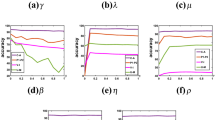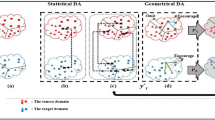Abstract
We address the problem of unsupervised visual domain adaptation for transferring category models from one visual domain or image data set to another. We present a new unsupervised domain adaptation algorithm based on subspace alignment. The core idea of our approach is to reduce the discrepancy between the source domain and the target domain in a latent discriminative subspace. Specifically, we first generate pseudo-labels for the target data by applying spectral clustering to a cross-domain similarity matrix, which is built from sparse coefficients found in a low-dimensional latent space. This coarse alignment between the two domains exploits the assumption that the collection of data of different classes from both domains can be viewed as samples from a union of low-dimensional subspaces. Then, we create discriminative subspaces for both domains using partial least squares correlation. Finally, a mapping which aligns the discriminative source subspace into the target one is learned by minimizing a Bregman matrix divergence function. Experimental results on benchmark cross-domain visual object recognition data sets and cross-view scene classification data sets demonstrate that the proposed method outperforms the baselines and several state-of-the-art competing methods.





Similar content being viewed by others
Explore related subjects
Discover the latest articles, news and stories from top researchers in related subjects.References
Griffin G, Holub A, Perona P (2007) Caltech-256 object category dataset (technical report), Caltech
Xiao J, Ehinger K, Hays J, Torralba A, Oliva A (2014) SUN database: exploring a large collection of scene categories. Int J Comput Vis 108:1–8
Gong B, Grauman K, Sha F (2014) Learning kernels for unsupervised domain adaptation with applications to visual object recognition. Int J Comput Vis 109:3–27
Lazebnik S, Schmid C, Ponce J (2006) Beyond bags of features: spatial pyramid matching for recognizing natural scene categories. In: Proceedings of IEEE conference on computer vision and pattern recognition, vol 2, pp 2169–2178
Dai D, Yang W (2011) Satellite image classification via two-layer sparse coding with biased image representation. IEEE Geosci Remote Sens Lett 8(1):173–176
Yang Y, Newsam S (2010) Bag-of-visual-words and spatial extensions for land-use classification. In: Proceedings of the ACM international conference on Advances in geographic information systems, ACM, New York, pp 270–279
Torralba A, Efros A (2011) Unbiased look at dataset bias. In: Proceedings of IEEE conference on computer vision and pattern recognition, vol 2, pp 1521–1528
Margolis A (2011) A literature review of domain adaptation with unlabeled data (technical report), University of Washington, Washington
Pan SJ, Yang Q (2010) A survey on transfer learning. IEEE Trans Knowl Data Eng 22(10):1345–1359
Shao L, Zhu F, Li X (2014) Transfer learning for visual categorization: a survey. IEEE TNNLS 26:1019–1034
Patel VM, Gopalan R, Li R, Chellappa R (2015) Visual domain adaptation: an overview of recent advances. In: IEEE signal processing magazine
Si S, Tao D, Geng B (2010) Bregman divergence-based regularization for transfer subspace learning. IEEE Trans Knowl Data Eng 22(7):929–942
Tuia D, Volpi M, Trolliet M, Camps-Valls G (2014) Semisupervised manifold alignment of multimodal remote sensing images. IEEE Trans Geosci Remote Sens 52(12):7708–7720
Pan SJ, Tsang IW, Kwok JT, Yang Q (2011) Domain adaptation via transfer component analysis. IEEE Trans Neural Netw 22(2):199–210
Chang SF (2012) Robust visual domain adaptation with low-rank reconstruction. In: Proceedings of IEEE conference on computer vision and pattern recognition, vol 2, pp 1–8
Shao M, Kit D, Fu Y (2014) Generalized transfer subspace learning through low-rank constraint. Int J Comput Vis 109:74–93
Gopalan R, Li R, Chellappa R (2011) Domain adaptation for object recognition: an unsupervised approach. In: Proceedings of IEEE international conference on computer vision, pp 999–1006
Baktashmotlagh M, Harandi MT, Lovell BC, Salzmann M (2013) Unsupervised domain adaptation by domain invariant projection. In: Proceedings of IEEE international conference on computer vision, pp 769–776
Fernando B, Habrard A, Sebban M, Tuytelaars T (2013) Unsupervised visual domain adaptation using subspace alignment. In: Proceedings of IEEE international conference on computer vision, pp 2960–2967
Ben-David S, Blitzer J, Crammer K, Kulesza A, Pereira F, Wortman J (2010) A theory of learning from different domains. Mach Learn 79:151–175
Elhamifar E, Vidal R (2013) Sparse subspace clustering: algorithm, theory, and applications. IEEE Trans Pattern Anal Mach Intell 35(11):2765–2781
Patel VM, Nguyen HV, Vidal R (2013) Latent space sparse subspace clustering. In: Proceedings of IEEE international conference on computer vision, pp 225–232
Levina E, Bickel PJ (2004) Maximum likelihood estimation of intrinsic dimension. In: Proceedings of the NIPS, pp 1–8
Van der Maaten L, Hinton G (2008) Visualizing data using t-sne. J Mach Learn Res 9(11):1–8
Risojevic V, Babic Z (2011) Aerial image classification using structural texture similarity. In: Proceedings of the IEEE international symposium on signal processing and information technology, pp 190–195
Acknowledgments
This work was supported in part by the National Natural Science Foundation of China under Grant 61303186 and by the Ph.D. Programs Foundation of Ministry of Education of China under Grant 20124307120013.
Author information
Authors and Affiliations
Corresponding author
Rights and permissions
About this article
Cite this article
Sun, H., Liu, S. & Zhou, S. Discriminative Subspace Alignment for Unsupervised Visual Domain Adaptation. Neural Process Lett 44, 779–793 (2016). https://doi.org/10.1007/s11063-015-9494-6
Published:
Issue Date:
DOI: https://doi.org/10.1007/s11063-015-9494-6




